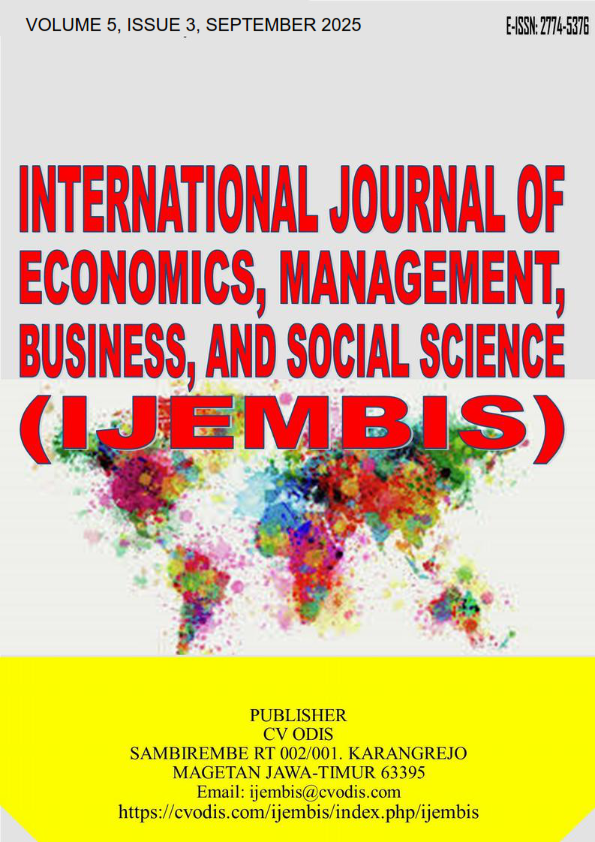The Effect of Education Level on Income Inequality: Empirical Evidence from Indonesia, 2015 – 2023
DOI:
https://doi.org/10.59889/ijembis.v5i3.472Keywords:
Income Inequality, Education, Panel Data Regression, Fixed Effect Model, LSDVAbstract
This study examines the effect of education on income inequality in Indonesia using panel data from 34 provinces over the period 2015-2023. The study investigates four main variables: average years of schooling, gross enrollment rate on tertiary education, government expenditure on education, and Gross Domestic Regional Product (GDRP) per capita. Applying a Fixed Effects Model with Least Square Dummy Variable (LSDV) approach, the findings indicate the longer average years of schooling are significantly associated with a reduction in income inequality. Government spending on education also reveals that greater expenditure leads to lower income inequality, reinforcing the role of public investment in promoting equity. Otherwise, an increase in the gross tertiary enrollment rate alone is insufficient to reduce income inequality unless accompanied by improvements in quality and access to education, and thus does not have a significant effect. GDRP per capita demonstrates a negative and significant relationship with income inequality, consistent with Kuznets’ theory that redistribution is supported by economic development at certain stages. The study emphasizes that to address the persistent regional income disparities in Indonesia, focused education policies and inclusive growth strategies are required.
Downloads
References
Arham, M. A., & Dai, S. I. S. (2019). Analysis of Funding, Education Performance, and Economic Growth in Indonesia. Jurnal Economia, 15(2), 292–305. https://doi.org/10.21831/economia.v15i2.26351
Becker, G. S. (1964). Human Capital: A Theoretical and Empirical Analysis with Special Reference to Education (3rd edition). The Universty of Chicago Press.
De Gregorio, J., & Lee, J. W. (2002). Education and income inequality: New evidence from cross-country data. Review of Income and Wealth, 48(3), 395–416. https://doi.org/10.1111/1475-4991.00060
Gross, C., Meyer, H. D., & Hadjar, A. (2016). Theorising the impact of education systems on inequalities. Education systems and inequalities: international comparisons, 11–31. https://doi.org/10.56687/9781447326113-005
Kaasa, A. (2003). Factors Influencing Income Inequality in Transition (Working Paper No.18). University of Tartu Economics and Business Administration.
Keller, K. R. I. (2010). How can education policy improve income distribution?: An empirical analysis of education stages and measures on income inequality. The Journal of Developing Areas, 43(2), 51–77. https://doi.org/10.1353/jda.0.0052
Kurniasih, E. P. (2017). Effect of economic growth on income inequality, labor absorption, and welfare in Indonesia. Economic Journal of Emerging Markets, 9(2), 181–188. https://doi.org/10.20885/ejem.vol9.iss2.art7
Kuznets, S. (1955). Economic growth and income inequality. The American Economic Review, 45(1), 1–28. https://www.jstor.org/stable/1811581
Park, K. H. (1996). Educational expansion and educational inequality on income distribution. Economics of Education Review, 15(1), 51–58. https://doi.org/10.1016/0272-7757(95)00000-3
Prannisa, A., Muljarijadi, B., & Wardhana, A. (2023). Government spending (economy, social protection, health, education) on income inequality in west java. Trikonomika, 22(1), 26–32. https://doi.org/10.23969/trikonomika.v22i1.5976
Purba, S. F., Khotimah, H., Suli, A. A. T., & Wahyuningsi, M. (2024). The impact of educational conditions on income inequality and economic growth in South Sumatra. KnE Social Sciences, 261–276. https://doi.org/10.18502/kss.v9i14.16104
Rahma Nur Imani, J., Nisa, K., Aziz, D., & Nusyirwan. (2020). Estimasi model fixed effect pada analisis regresi data panel dengan metode Least Square Dummy Variable (LSDV). Journal of Statistic, Probability, and Its Application, 3(1), 1–14. http://digilib.unila.ac.id/62159/
Seefeldt, B. (2018). The impact of education expenditures on income inequality: Evidence from US states. Undergraduate Economic Review, 15. https://doi.org/10.2139/ssrn.3617194
Sylwester, K. (2002). Can education expenditures reduce income inequality? Economics of Education Review, 21(1), 43–52. https://doi.org/10.1016/S0272-7757(00)00038-8
Thye, G. L., Law, S. H., & Trinugroho, I. (2022). Human capital development and income inequality in Indonesia: Evidence from a nonlinear autoregressive distributed lag (NARDL) analysis. Cogent Economics and Finance, 10(1), 1–17. https://doi.org/10.1080/23322039.2022.2129372
Todaro, M. P., & Smith, S. C. (2011). Pembangunan Ekonomi di Dunia Ketiga Edisi Kesebelas. Jakarta: Erlangga.
Wolde, M., Sera, L., & Merra, T. M. (2022). Causal relationship between income inequality and economic growth in Ethiopia. Cogent Economics and Finance, 10(1). https://doi.org/10.1080/23322039.2022.2087299
Yang, J., & Qiu, M. (2016). The impact of education on income inequality and intergenerational mobility. China Economic Review, 37, 110–125. https://doi.org/10.1016/j.chieco.2015.12.009
Downloads
Published
How to Cite
Issue
Section
License
Copyright (c) 2025 Aulia Hammidah Haryono, Wahyu Widodo

This work is licensed under a Creative Commons Attribution 4.0 International License.









